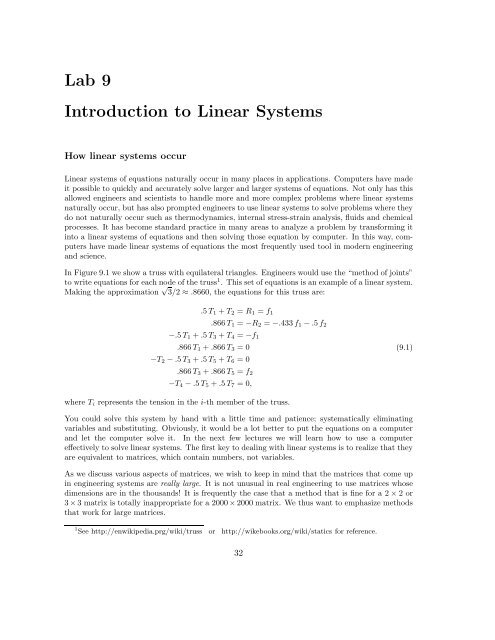Introduction to Numerical Math and Matlab ... - Ohio University
Introduction to Numerical Math and Matlab ... - Ohio University
Introduction to Numerical Math and Matlab ... - Ohio University
Create successful ePaper yourself
Turn your PDF publications into a flip-book with our unique Google optimized e-Paper software.
Lab 9<br />
<strong>Introduction</strong> <strong>to</strong> Linear Systems<br />
How linear systems occur<br />
Linear systems of equations naturally occur in many places in applications. Computers have made<br />
it possible <strong>to</strong> quickly <strong>and</strong> accurately solve larger <strong>and</strong> larger systems of equations. Not only has this<br />
allowed engineers <strong>and</strong> scientists <strong>to</strong> h<strong>and</strong>le more <strong>and</strong> more complex problems where linear systems<br />
naturally occur, but has also prompted engineers <strong>to</strong> use linear systems <strong>to</strong> solve problems where they<br />
do not naturally occur such as thermodynamics, internal stress-strain analysis, fluids <strong>and</strong> chemical<br />
processes. It has become st<strong>and</strong>ard practice in many areas <strong>to</strong> analyze a problem by transforming it<br />
in<strong>to</strong> a linear systems of equations <strong>and</strong> then solving those equation by computer. In this way, computers<br />
have made linear systems of equations the most frequently used <strong>to</strong>ol in modern engineering<br />
<strong>and</strong> science.<br />
In Figure 9.1 we show a truss with equilateral triangles. Engineers would use the “method of joints”<br />
<strong>to</strong> write equations for each node of the truss 1 . This set of equations is an example of a linear system.<br />
Making the approximation √ 3/2 ≈ .8660, the equations for this truss are:<br />
.5 T 1 + T 2 = R 1 = f 1<br />
.866 T 1 = −R 2 = −.433 f 1 − .5 f 2<br />
−.5 T 1 + .5 T 3 + T 4 = −f 1<br />
.866 T 1 + .866 T 3 = 0<br />
−T 2 − .5 T 3 + .5 T 5 + T 6 = 0<br />
(9.1)<br />
.866 T 3 + .866 T 5 = f 2<br />
−T 4 − .5 T 5 + .5 T 7 = 0,<br />
where T i represents the tension in the i-th member of the truss.<br />
You could solve this system by h<strong>and</strong> with a little time <strong>and</strong> patience; systematically eliminating<br />
variables <strong>and</strong> substituting. Obviously, it would be a lot better <strong>to</strong> put the equations on a computer<br />
<strong>and</strong> let the computer solve it. In the next few lectures we will learn how <strong>to</strong> use a computer<br />
effectively <strong>to</strong> solve linear systems. The first key <strong>to</strong> dealing with linear systems is <strong>to</strong> realize that they<br />
are equivalent <strong>to</strong> matrices, which contain numbers, not variables.<br />
As we discuss various aspects of matrices, we wish <strong>to</strong> keep in mind that the matrices that come up<br />
in engineering systems are really large. It is not unusual in real engineering <strong>to</strong> use matrices whose<br />
dimensions are in the thous<strong>and</strong>s! It is frequently the case that a method that is fine for a 2 × 2 or<br />
3 ×3 matrix is <strong>to</strong>tally inappropriate for a 2000 ×2000 matrix. We thus want <strong>to</strong> emphasize methods<br />
that work for large matrices.<br />
1 See http://enwikipedia.prg/wiki/truss or http://wikebooks.org/wiki/statics for reference.<br />
32
















